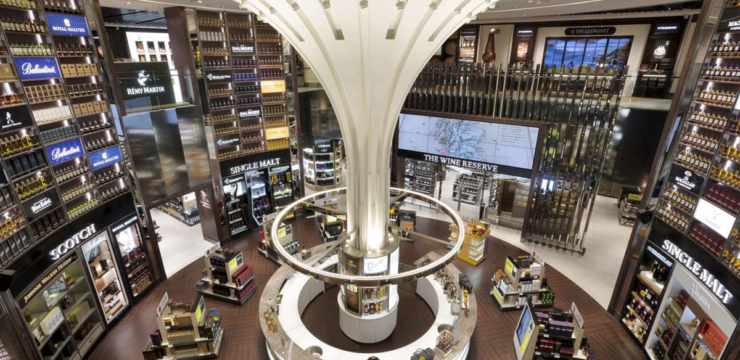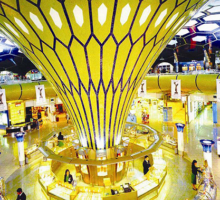What characteristics and dynamics influence a purchase.
Find out why you should carefully select the retailers with whom to enter into trade agreements, based on their sales areas and which specific requests you should express about the way to display and present your products.
Bringing the products you have in the catalogue into the duty free is certainly a victory; it is the main aim of achievement that professionals like myself strive for 365 days a year, but is certainly not enough. Not all retail spaces are the same, not all guarantee the same conversion rate of visitors into customers, especially if your products are not efficiently placed and displayed how they should be.
Sociologists, psychologists and marketing professionals have been conducting studies for years about the way in which the design of a retail space influences purchasing dynamics. We must find how to identify the right location for your products and the specific corner of the shop able to ensure you the best conversion rate. As you will see, it is not only spatial elements that matter, but, overall, everything that is able to act on each individual sensory dimension.
DESIGN
From crossing the entrance, right up to the checkout, all the design elements of a shop have an influence on the conversion rate of visitors.
Knowing the most common design strategies will guarantee you the possibility of expressing specific requests about the location of your products and understanding why sometimes, a product of one of your competitors is purchased more, even if it is more expensive and of a lower quality than yours.
The decompression zone
The shop entrance is the place where your potential customer is experiencing a real transition between two worlds, the outside of the shop and the magical world of duty free.
The clear majority of duty free shops around the world is structured to have multiple access points, so each of them functions a s a decompression zone.
In this area, customers have an initial idea about what the entire range of products offered to them is, especially in terms of quality.
Certainly, this area is extremely important in defining the entire purchasing experience, but, I guarantee you that you don’t want your products to be located here. This is because customers tend to not consider products located at the entrance as they are in the transition phase and still haven’t immersed themselves in the shopping mood.
Immediately to the right
Already consolidated statistics state that 90% of customers of a shop go immediately to the right after experiencing the transition at the entrance. The display to the right of the entrance is defined as a “power wall”. As you will have understood, this space has enormous potential in terms of converting visitors; ask for your products to be displayed here.
Follow the route
The design of a good shop, duty free included, is always developed to provide routes for the customers. This does not occur only with physically fixed routes, as in the famous case of IKEA sales outlets; the indications given today to customers are much less explicit and require no walls or barriers. Identify the points in which a change of direction is subtly indicated to customers and ask for your products to be displayed there. You can recognise these places by the presence of a sign with an offer or, much more frequently by the display of a product ably to capture the attention the most (e.g. a stand of confectionery products).
Slow down
The final goal of every retailer is to lead customers to purchasing as many products as possible. The study of specific routes is exactly for this. But if customers, maybe because they are already sure of what they want to buy, finish the route too quickly and end up purchasing few products, if any at all! In this case again, the decades of studies on this field have come up with a solution: the insertion of pause points, places where there is a break with the layout of the shop, which reactivate the customers’ attention. You can recognise these places by any “visual break”, aesthetically inconsistent signs or stands compared to others (e.g. a wicker basket with ……. your products maybe?).
THE 5 SENSES
The whole purchasing experience is influenced by every sense, all five of them.
Specific cognitive processes that favour the purchase are triggered by certain sensorial stimuli. This is the reason for careful study on duty free lighting rather than on the temperature of the places. Customers don’t perceive these elements as marketing messages but are still influenced by them. Well, avoid any cold location, (it is scientifically proven that warm places favour purchasing); ask for your products to be displayed in a well-lit corner (80% of sensorial information the human brain uses comes from sight), take noise into consideration (too often, but inevitably, ruined by airport service messages).
You should ensure that the packaging of your products conveys a pleasant tactile experience and, in the case your products, like mine, fall within the Food & Beverage category, read the next paragraph carefully.
TASTING
If you sell clothing, you will rarely see a customer sniffing your product and (nearly) never see someone enquiring about its taste.
But what if you have products in the catalogue that their main standards are in their taste and smell? I have put a team of food tasting specialists in my team, because I truly believe in the power of my potential customers trying my products.
Despite having the advantage to be able to profit from the fame of the now universally recognised Made in Italy brand on my side, I have developed a series of services for my retailer customers to help them in better conveying the excellent quality of my products.
I offer two types of services: I provide my team to set up special stands or organise courses to train their shop assistants. My advice is to provide, maybe in those “pause points” that I mentioned before, some points for tasting your products.
I want to communicate one simple thing with this article: your work never ends after having placed your products inside a duty-free shop. Always ask for a floor plan of the sales outlets in which your products will be sold and, immediately after studying it, personally visit the shop, identify the best display area and implement a marketing strategy able to act on all the senses of your potential customers.




